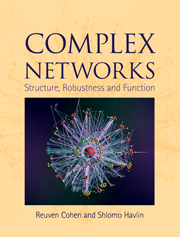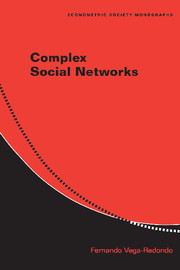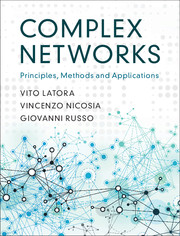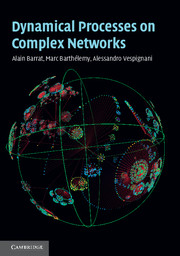Complex Networks
Structure, Robustness and Function
£40.99
- Authors:
- Reuven Cohen, Weizmann Institute of Science, Israel
- Shlomo Havlin, Bar-Ilan University, Israel
- Date Published: July 2010
- availability: Available
- format: Hardback
- isbn: 9780521841566
£
40.99
Hardback
Other available formats:
eBook
Looking for an inspection copy?
This title is not currently available on inspection
-
Examining important results and analytical techniques, this graduate-level textbook is a step-by-step presentation of the structure and function of complex networks. Using a range of examples, from the stability of the internet to efficient methods of immunizing populations, and from epidemic spreading to how one might efficiently search for individuals, this textbook explains the theoretical methods that can be used, and the experimental and analytical results obtained in the study and research of complex networks. Giving detailed derivations of many results in complex networks theory, this is an ideal text to be used by graduate students entering the field. End-of-chapter review questions help students monitor their own understanding of the materials presented.
Read more- Covers a range of subjects, from the stability of the internet to efficient methods of immunizing populations, to give the reader a broad presentation of the topic
- Focuses on analytical techniques to give readers the basic tools to use in their own research
- Each chapter ends with review questions so that students can monitor their understanding of the material presented
Customer reviews
Not yet reviewed
Be the first to review
Review was not posted due to profanity
×Product details
- Date Published: July 2010
- format: Hardback
- isbn: 9780521841566
- length: 248 pages
- dimensions: 253 x 193 x 16 mm
- weight: 0.7kg
- contains: 56 b/w illus. 65 exercises
- availability: Available
Table of Contents
1. Introduction
Part I. Random Network Models:
2. The Erdos–Renyi models
3. Observations in real-world networks
4. Models for complex networks
5. Growing network models
Part II. Structure and Robustness of Complex Networks:
6. Distances in scale-free networks: the ultra small world
7. Self-similarity in complex networks
8. Distances in geographically embedded networks
9. The network's structure - the generating function method
10. Percolation on complex networks
11. Structure of random directed networks - the bow tie
12. Introducing weights: bandwidth allocation and multimedia broadcasting
Part III. Network Function: Dynamics and Applications:
13. Optimization of the network structure
14. Epidemiological models
15. Immunization
16. Thermodynamic models on networks
17. Spectral properties, transport, diffusion and dynamics
18. Searching in networks
19. Biological networks and network motifs
Part Appendix A. Probability theoretical methods
Appendix B. Asymptotics and orders of magnitude
Appendix C. Algorithms for network simulation and investigation
References
Index.
Sorry, this resource is locked
Please register or sign in to request access. If you are having problems accessing these resources please email [email protected]
Register Sign in» Proceed
You are now leaving the Cambridge University Press website. Your eBook purchase and download will be completed by our partner www.ebooks.com. Please see the permission section of the www.ebooks.com catalogue page for details of the print & copy limits on our eBooks.
Continue ×Are you sure you want to delete your account?
This cannot be undone.
Thank you for your feedback which will help us improve our service.
If you requested a response, we will make sure to get back to you shortly.
×





